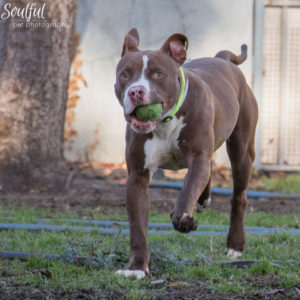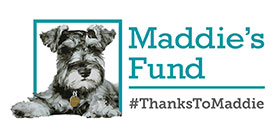The usual profile of a jumpy/mouthy dog is an adolescent or young adult dog with a friendly, confident and playful personality. Generally, these dogs lack training and never learned behavioral inhibition. They jump up on people, grab clothing or leashes, and become very mouthy during play or when aroused. Usually, this mouthing doesn’t hurt, but sometimes it does – it depends on the dog and his excitement level. Some dogs may also attempt to mount people or other dogs when they get excited or stressed. None of these are “dominance” related behaviors; they are simply normal canine responses to excitement, energy or stress.
Fear issues from lack of socialization can sometimes be noted in jumpy/mouthy dogs. Therefore, it is important to avoid punishment based training solutions. Punitive or aversive methods may be misinterpreted by the dog resulting in increased anxiety, fear and frustration.
All training plans require management to keep the behavior from reoccurring; but exercise, enrichment, and training are also necessary to achieve results. Download this Training Guide PDF for more information.
Exercise & Enrichment
- Increase your dog’s exercise routine to at least 2 long walks a day (besides regular breaks to relieve himself). These walks should be a minimum of 30 minutes each and incorporate different routes for enrichment purposes
- Jogging or running next to a bicycle can help to tire out a dog with excessive energy
- Use a flirt pole for your dog to chase in an enclosed yard
- Teach your dog retrieve a ball in the yard
- For social dogs, set up play times with other social dogs.
Many people make the mistake of ONLY providing physical exercise. This is not enough! You have to also ensure that your dog is mentally stimulated! Play brain games and feed your dog out of a slow feeder, KONG or other puzzle toy. See Indoor Games & Dog Toy pages for more information.
Training

- Teach an Auto-Sit. Lure your dog into a sit with a treat five times. Then wait for him to offer a sit without saying anything. Reward by tossing a treat to the side so that he has to get up to get it. When he starts to auto sit, stop luring. Practice in different locations and with different people.
- Reward good behavior. When your dog makes the choice of not jumping, mouthing or mounting in situations where he normally would, calmly say “Good” and have a playtime or feed a piece of kibble / treat.
- Teach Tug (for mouthing). Get a braided fleece tug toy. Keep it out of sight most of the time, and when you are ready to train, bring it out. Ask or wait for a sit (see Auto-Sit above) before offering the toy to your dog. Play tug. If/when his teeth make contact with your skin, say “oops!” Immediately stop tugging on the toy, but do not release it. Just keep your hands still and zip your lips. As soon as he drops it, say “Good dog!” and start playing again. If/when he puts his mouth on you three times, the tug toy goes away and all play stops.
- Teach your dog to relax on a mat or bed. See Relaxation Page
- Use the dog’s daily walks to practice training and impulse control. See Loose Leash Training
Management
- Discourage all jumpy/mouthy behavior from the dog. Consistency is imperative for results. Withdraw all attention and turn away from the dog when jumping or mouthing occurs.
- Give your dog an alternative. Most dogs have specific times that they get excited and tend to jump/mouth/mount. For example, if you know your dog becomes mouthy when you get home from work at the end of the day, put a basket of toys near the front door. When your dog approaches to greet you, put one of the toys in your dog’s mouth or toss a toy for your dog to pick-up.
- Redirect your dog. If your dog starts mounting, redirect him to more appropriate behavior by tossing a toy, playing a game, giving him a chewy, or asking him to perform some previously learned basic obedience skills or tricks that he enjoys (sit, down, shake, etc.).
- Cool-Down. If your dog is getting too excited and provide a brief 5 minute cool-down period so he can regain control of himself in a safe and calm environment. The brief cool-down can be achieved by putting him in a crate, tie down (only if supervised), or putting him in dog-proof room with something to work on by himself; like a long lasting chew (stuffed Kong, bully stick, bone, etc.). When you release him be prepared with a toy to stuff in his mouth and have a treat ready to reward an auto-sit. If he jumps/mouths/mounts, repeat the cool-down.
- Step on the leash. Leash the dog and step on the leash if the jumping persists.
- Have the dog learn to sit before and during greetings with other people.
- Note that methods such as using a loud noise or spray water bottle often cause jumpy/mouthy behavior to worsen as the dog’s frustration increases. Even if you successfully curb their behavior, you have only taught the dog to suppress their behavior out of fear, without teaching them any new skills on what behavior you would like instead
If you are not successful in curbing your dog’s unwanted behaviors, please contact a local certified dog trainer or behavior consultant. You can find a list of recommended behavior professionals here.
